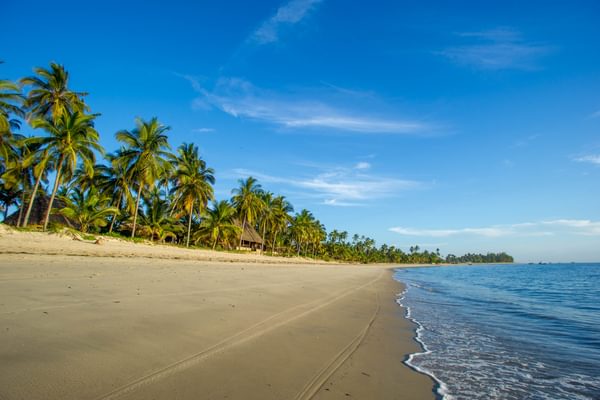Speak To Our Tanzania Expert Today
and start planning your tailor-made holiday

Alistair
Travel Expert

Can't decide where to go? Why not peruse some of our most popular destinations for inspiration then give us a call!

A diverse land brimming with superb safaris, pristine sandy beaches, towering snow-capped peaks and tropical underwater worlds is just waiting to welcome you

Australia offers vibrant cities, diverse landscapes, and iconic wonders like the Great Barrier Reef. New Zealand adds dramatic scenery, Maori culture, and relaxed charm. Together, they promise nature, adventure, culture, and warm hospitality.

If you're dreaming of an island getaway, look no further than the Caribbean with its gorgeous soft sand beaches and lively, diverse cultures.

Head to the amazing destination that is Central America, full of the knowledge of ancient civilizations, incredible mountains, and beautiful beaches.

Discover vibrant cultures, pristine beaches, and tantalizing flavours in the captivating travel haven that is East and Southeast Asia

Embark on a journey through the vibrant tapestry of India, Sri Lanka, and Bhutan—where ancient temples, lush tea plantations, and soaring Himalayan peaks promise unforgettable moments at every turn.

Picture yourself basking on sun-kissed beaches, sipping tropical cocktails beneath swaying palms —where crystal-clear lagoons and luxurious resorts cater to your every desire.

Experience world-class hospitality, mouthwatering cuisines, and the region’s deep-rooted cultural traditions for an unforgettable Middle East adventure.

Venture to the ends of the Earth and behold the icy majesty of polar landscapes. Discover pristine solitude, exhilarating expeditions, and breathtaking views that promise a memorable encounter with nature at its most dramatic

Journey into the heart of South America, where the rhythmic pulse of its vibrant cities meets the majesty of the Amazon rainforest and the timeless wonder of ancient civilizations.

The South Pacific is a paradise of turquoise waters, white-sand beaches, and vibrant island cultures. From adventure and natural beauty to pure relaxation, each island offers its own unique charm and welcome.

From the soaring plains of the Southwestern USA to the stunning landscapes of the expanses of Canada, visit some of the most impressive scenery in the world

If you are looking for a trip to knock iconic locations off your bucket list, check out our buck list recommendations

From the graceful stride of giraffes at sunrise to the echoing roars of lions beneath starlit skies, each of our safaris promises an unforgettable dance with nature.


Our family holidays are a perfect opportunity to create lasting memories, whether exploring new destinations or simply enjoying quality time together. From adventure-filled escapes to relaxing beach retreats, they offer a chance to reconnect and unwind away from daily routines.

Our luxury holidays offer the finest experiences, from exclusive resorts and private villas to tailor-made adventures with impeccable service.

For those seeking adventure beyond the usual tourist trails, our off-the-beaten-track trips take you to some of the world’s most remote and untouched destinations, where authentic cultural encounters and breathtaking landscapes await. Let us craft your unique journeys that few travellers ever experience.

For the ultimate beach escape, we offer luxury holidays to some of the world’s most stunning coastal destinations, from the white-sand shores of Antigua to the turquoise waters of Zanzibar.

For those who crave excitement and exploration, our adventure holidays take you to some of the world’s most thrilling destinations, whether trekking through Patagonia, summiting Mount Kenya, or kayaking past icebergs in Antarctica.

Interested in something a bit more focused? How about a horse-riding holiday through Argentina? Or a photography safari? Look through our Special Interest holiday selection for inspiration

Our wildlife holidays invite you to step into unique ecosystems and experience amazing animal encounters. Whether spotting majestic tigers in the jungles of India or marvelling at polar bears in the Arctic, each trip promises awe-inspiring moments steeped in the magic of nature.

Our small group tours offer the perfect balance of expert-guided exploration and personal experience, taking you to incredible destinations with like-minded travellers. Whether it's a wildlife safari in Botswana, a cultural journey through Vietnam, or a chef-led expedition through India, our carefully curated itineraries ensure an intimate, enriching, and hassle-free experience.

Sustainability travel is at the core of what we do and a guiding principle in every choice we make as a business. Let us help you make sustainable travel choices

Read about what we do to make a difference

One of the most important parts of our commitment to responsible travel is protecting our clients, and it is a part that we take extremely seriously.

Not sure what's best for which time of year? Check out our expert-written guides

Looking for some expertise on your destination? Have a look through our selection of guides and articles written by our destination experts

Looking for more inspiration? Read from our range of hundreds of articles from our travel specialists, local guides, and personal travel tales.

Our mission is to make every holiday special. We will do this whilst specifically aiming to minimise the environmental impact of our activity and maximise our opportunity to influence others to do the same.
Helpful tips to help plan your epic Kilimanjaro Climb
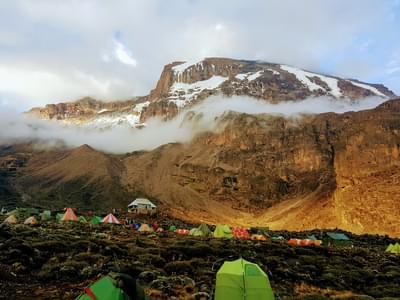
The weather patterns on and around Kilimanjaro closely follow the general weather patterns that affect the rest of Tanzania. There are two distinct times of the year which should be avoided for a Kilimanjaro climb and these are during the rainy season, which are between April and May, referred to as the 'long rains' and in November, referred to as the 'short rains'.. The long rains generally have longer and heavier precipitation.
The weather is one of the most important considerations, especially if you are not an experienced mountain climber and not used to the harsh conditions that can sometimes present themselves. Rain, sleet, ice and very low temperatures can severely affect your ability to function both physically and mentally. Therefore less experienced climbers should keep to the fair weather months during January - Feb and July - Oct. January and February are the hottest months in Tanzania with generally fewer clouds so the summit can be seen more of the time. Between end of June and end of October it is also a good time but it will be colder up the mountain.
Of-course the better months to climb the mountain do attract more climbers so there will be more traffic on the mountain. However if that is an issue for you then choose one of the newer, less frequented routes, such as Lemosho.
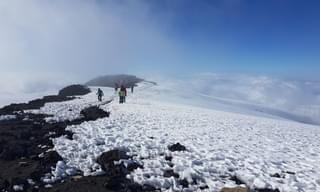
The most common mistake is for climbers to pack too much. You will need to be very selective when packing and bear in mind that the porters are limited to carrying 15 kgs.
All your gear should be packed in a duffel bag (50-90 litres) including your sleeping bag (which should be a '4 seasons' standard). The porters then put these into a waterproof bag with a roll top closure.
The essentials to bring are a sturdy pair of walking boots that support the ankles. Make sure they are already worn in, as many people splash out on a fancy new pair of boots before the trip and don't wear them in properly resulting in blisters and very sore feet after day 1. It can make the trip a miserable one for you and potentially prevent you from reaching the top. You would be better off with an older pair of boots that might not look so cool but are properly worn in and will get you to the top.
A good waterproof is essential as it can get very wet up the mountain especially through the rain forest. You want to avoid getting your underclothes wet before you move into the higher altitudes where it is significantly colder as it will reduce their ability to keep you warm.
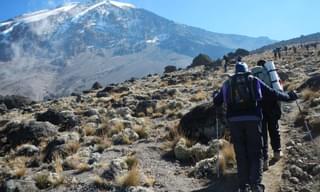
An insulated jacket (either synthetic or down filled) and a fleece are essential items. Also under-garments should be made from moisture-wicking fabric which does not absorb water in the same way as natural fabrics. This keeps the garment dry and retains its insulating properties.
Waking poles are a very useful item to bring as they really help reduce the stress on your leg muscles by using the upper body muscles to assist with the walking motion. They also help with stability in rocky and infirm terrain such as you will encounter on Kilimanjaro.
Other smaller items that are useful to bring include hand sanitiser, as the washing facilities are basic and it is important to reduce the risk of a tummy bug, which will drain your body of energy and make you less less likely to reach the summit. Wet wipes are also useful to take for the same reason.
Sun cream and lip balm are essential items. The sun is much stronger at higher altitude and the reflecting properties of the white snow add to the strength of the suns impact on your skin. Use a high factor cream and a lip balm that is also a sun blocker.
This is not a complete kit list, which will be provided by Far & Wild prior to your trip.
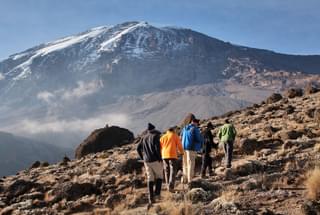
Climbing Mount Kilimanjaro is physically challenging, so some degree of fitness is required. The up-hill walk requires strong legs and general aerobic fitness is needed to carry essential oxygen around your body. A fit person is more likely to withstand the gruelling consecutive days of camping and walking for hours in cold and inclement weather conditions. Mental fitness is also important and a positive mental attitude and will to succeed will stave off the fatigue and negative thoughts.
The best form of exercise is simply to do lots of hiking, preferably in a mountain environment with lots of uphills, which will simulate climbing Mount Kilimanjaro. Long day hikes are best as again this closely resembles what you will experience on the climb. If you are unable to get to the mountains or long trails regularly then you can train quite productively on a stair master machine as this will strengthen the muscles needed for uphill walking. This would need to be combined with extended long walks at the weekends.
You should start training for climbing Kilimanjaro at least two months prior to your departure.
If you've never hiked before, you should start with shorter time intervals, a slower pace, and no weight (in your day pack) and then gradually increase all of the above as your fitness level improves. Try to train three times a week, for at least one hour per session, at a minimum. Go on days for 4 to 6 hours with a 20 kg pack once you have built up your initial strength, and better to walk more slowly for longer periods than faster and shorter, as the walking on Kilimanjaro will be at a slow pace and more about endurance. It is also important to do some aerobic exercises such as running, cycling or swimming which will increase the aerobic capacity of your body.
Your longest walks and work outs should be between 2 and 4 weeks prior to your departure for Tanzania. The last two weeks reduce your training and for the final days stop all together to give your body time to recover before the climb.
It's important that during your training you wear the boots you intend to take with you on your trip and also carry the back pack you intent to take. This will minimise any sores to your feet and shoulders.
Lastly, physical training is just one part of getting in shape. Preparing mentally and eating a healthy diet are also important, as is getting a good amount of sleep.
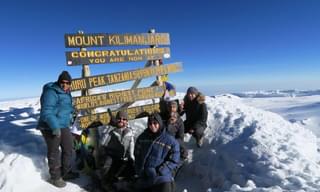
The effects of high altitude on the body can be serious and in some cases fatal, and differ from one person to the next. It's not always related to fitness levels. I have met super fit guys running up the trail to the Annapurna base camp in the Himalayas who all got very sick due to the altitude.
There is little you can do prior to coming to Tanzania to help you with this unless you happen to live somewhere like the Swiss Alps.
The best way to avoid any issues is to ensure you acclimatize properly and this means doing a route that takes no less than 6 days - more days is better. Some routes you will find advertised do it in 5, but these are not recommended. If you have more time you could arrive in Tanzania a few days before your trek and hike up to Mt Meru which is a stunningly beautiful trek through the lush bush of Arusha National Park before getting onto the mountain. There is plenty of wildlife in the park including elephants, lions, leopard, giraffe etc so it's a great opportunity to see the incredible wildlife of Tanzania whilst in the country.
You will be briefed by your guide about the symptoms of altitude sickness and it is important to listen carefully and heed their words. If you show any signs of the symptoms, or you see any of your co-climbers showing signs you must inform the guide immediately and reduce altitude.
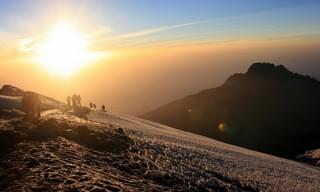
It is advisable to see a doctor before you go and inform them of your intentions to climb Kilimanjaro. If you are on any medications they may not work at higher altitudes or if you have a pre-existing medical condition you need to know if the climb and the altitude is going to be a problem.
It is best to seek this advice before you book and commit to an expensive holiday.
To climb Kilimanjaro is no walk in the park and will push you and challenge you both mentally and physically, but it can be one of the most rewarding experiences of your life. It should be considered carefully and the training and preparations should be taken seriously which will make reaching the summit all the more rewarding.
Good Luck!
and start planning your tailor-made holiday

Travel Expert
What can I say….my son and myself had the most wonderful time in Kenya thanks to the first-class itinerary that Ben and Louise put together for us. We spoke with Ben many times to ensure he ‘got it right’. This was our 2nd visit to Kenya, and it certainly lived up to our expectations and memories. Nothing was too much trouble for all the staff; we cannot have been looked after any better. I would highly recommend Far and Wild; they are so knowledgeable and have personally visited the lodges and areas. We are already planning another visit, and we cannot wait.
I have just returned from the most amazing trip to Tanzania, booked with Far & Wild. Everything went so smoothly from the first time I spoke with them. The planning was great, the itinerary was perfect for us, and the lodges were amazing. We spent 10 nights with an amazing guide, travelling through Northern Tanzania and even got to see the migration, which was a lifetime ambition of mine. This wasn't our first safari, so we were nervous as to how it would compare, but it was spot on. I will certainly be using them again to book our next trip....we're thinking of a relaxing beach stay next time to get over the excitement of safari!
Just back from another amazing F&W organised trip to Namibia with the family (8 adults). Having been there before, Alistair tailored our trip to include our favourite locations and added a new one for us, which we loved.The quality of accommodation and guiding, activities, food and drinks was exceptional throughout. It was good value for the level of luxury we had.
We had a wonderful trip to São Tomé and Príncipe - a small island nation in the Gulf of Guinea with paradise (almost empty) beaches and jungle forest. It was all well organised by Far and Wild and we stayed at a great combination of different types of resorts/hotels. We really recommend this for those who want to experience a pristine destination with few other tourists and friendly and welcoming people. The islands also feel very safe. At Principe, there are no dangerous animals, snakes or whatever, and it was great to be able to hike in the jungle without being very conscious of where to put your hands and feet. Go before everyone else does!
Back home again, basking in the joys of a superb safari. Every aspect you arranged for us, including linking up with Mack Air and Wild Horizons locally to transport us. The choice of camps was ideally situated, comfortable, in good surroundings, and with excellent wildlife on the doorstep and throughout the wider country. The service staff in each looked after us very well, catering was excellent, and the game guides were professional, knowledgeable and helpful. You made us happy, and we recommend you to similar safari enthusiasts with confidence.
Far and Wild went above and beyond to make sure my trip to Zambia was special. I would definitely recommend them and their services to anyone wanting to travel to Africa.
Lovely holiday at the amazing Almanara on Galu beach, a beach like no other. Far and Wild excelled themselves from beginning to end of our holiday in beautiful Kenya.... What a country!,
Wow! These guys are amazing. Can’t recommend them highly enough. Friendly AND efficient! Sorted out our trip (last minute and lots of different family member needs, sorry!) in record time and everything worked like clockwork. Trip of a lifetime to the Masai Mara. Will be back (and use F&W again!)!
It was a dreamy holiday on the Kenyan Coast - Far and Wild, their efficiency and professionalism allowed us to relax and be the happiest family alive !! We cannot fault them, their care and understanding of what we wanted from a holiday ensured we had the most memorable trip. We will be booking with them again for sure!
Get travel tips directly to your inbox every week
Give us a call on 0203 111 1315 or fill in the form below and we’ll be in touch.
